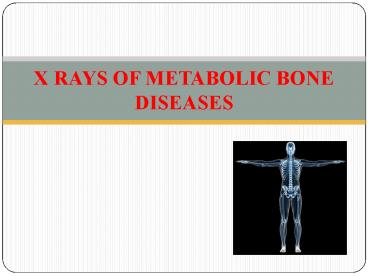X RAYS OF METABOLIC BONE DISEASES - PowerPoint PPT Presentation
Title:
X RAYS OF METABOLIC BONE DISEASES
Description:
Title: INFECTIONS: ORTHOPEDICS Author: Dr.Vijay Singh Last modified by: VINEET KUMAR Created Date: 8/16/2006 12:00:00 AM Document presentation format – PowerPoint PPT presentation
Number of Views:73
Avg rating:3.0/5.0
Title: X RAYS OF METABOLIC BONE DISEASES
1
X RAYS OF METABOLIC BONE DISEASES
2
CONTENTS
- XRAY OF METABOLIC DISEASE OF BONE
- SUMMARY
3
XRAY OF METABOLIC DISEASE OF BONE
4
INTRODUCTION
- Metabolic bone diseases are a heterogeneous group
of disorders characterized by abnormalities in
calcium metabolism and/or bone cell physiology. - They lead to an altered serum calcium
concentration and/or skeletal failure. - The most common type of metabolic bone disease in
developed countries is osteoporosis. - Because osteoporosis is essentially a disease of
the elderly, the prevalence of this condition is
increasing as the average age of people in
developed countries rises. - Osteoporotic fractures may lead to loss of
independence in the elderly and is imposing an
ever-increasing social and economic burden on
society
https//www.blackwellpublishing.com/content/BPL_Im
ages/Content_store/Sample_chapter/9780632051625/Ax
fordChap5.pdf
5
PAGETS DISEASE
- Pagets disease of bone is a localized disorder
of bone remodelling that results in a
disorganized structure of woven and lamellar
bone. - This reveals generalized expansion and deformity
of affected long bones, with a characteristic
lytic leading edge (blade of grass appearance).
- There may also be areas of sclerotic bone at
sites of osteoblastic reaction. - When Pagets disease affects the skull,
characteristic widening of the skull vault may be
seen, or broad scalloped areas of lysis
(osteoporosis circumscripta).
https//www.blackwellpublishing.com/content/BPL_Im
ages/Content_store/Sample_chapter/9780632051625/Ax
fordChap5.pdf
6
- Radiograph demonstrating Pagets disease of bone.
- There is thickening of the skull vault and
regions of lucency and sclerosis (arrows).
https//www.blackwellpublishing.com/content/BPL_Im
ages/Content_store/Sample_chapter/9780632051625/Ax
fordChap5.pdf
7
HYPERPARATHYROIDISM
- This commonly shows a diffuse reduction in bone
density. Radiological evidence of osteitis
fibrosa cystica is present in less than 5 of
patients at diagnosis. - It consists of subperiosteal bone resorption
(best seen along the radial aspect of middle
phalanges), erosions of the tufts of the terminal
phalanges, mottling of the skull vault
(salt-and-pepper appearance), cystic lesions
and loss of the lamina dura. - There may also be radiological evidence of
nephrocalcinosis.
https//www.blackwellpublishing.com/content/BPL_Im
ages/Content_store/Sample_chapter/9780632051625/Ax
fordChap5.pdf
8
https//www.blackwellpublishing.com/content/BPL_Im
ages/Content_store/Sample_chapter/9780632051625/Ax
fordChap5.pdf
9
https//www.blackwellpublishing.com/content/BPL_Im
ages/Content_store/Sample_chapter/9780632051625/Ax
fordChap5.pdf
10
https//www.blackwellpublishing.com/content/BPL_Im
ages/Content_store/Sample_chapter/9780632051625/Ax
fordChap5.pdf
11
HYPERCALCAEMIA OF MALIGNANCY
- Hypercalcaemia of malignancy is usually an
indicator of advanced disease with secondary
skeletal deposits and is rarely the first
manifestation. - Plain radiography may reveal an osteolytic bone
lesion or evidence of a primary malignancy such
as lung neoplasm
https//www.blackwellpublishing.com/content/BPL_Im
ages/Content_store/Sample_chapter/9780632051625/Ax
fordChap5.pdf
12
https//www.blackwellpublishing.com/content/BPL_Im
ages/Content_store/Sample_chapter/9780632051625/Ax
fordChap5.pdf
13
HYPOCALCAEMIA
- Hypocalcaemia is a less common clinical problem
than hypercalcaemia and has fewer causes. - Like hypercalcaemia, its presentation varies from
an asymptomatic biochemical abnormality to a
life-threatening condition. - Plain radiography. Changes of renal
osteodystrophy or osteomalacia/rickets are likely
if chronic renal failure or vitamin D deficiency
is severe enough to cause hypocalcaemia. - In childhood hypoparathyroidism, radiographs may
reveal skeletal abnormalities characteristic of
pseudohypoparathyroidism.
https//www.blackwellpublishing.com/content/BPL_Im
ages/Content_store/Sample_chapter/9780632051625/Ax
fordChap5.pdf
14
OSTEOPENIA
https//www.blackwellpublishing.com/content/BPL_Im
ages/Content_store/Sample_chapter/9780632051625/Ax
fordChap5.pdf
15
SUMMARY
- Radiograph is an important modality for the
diagnosis of bone infections like Tuberculosis,
osteomyelitis etc and metabolic diseases like
hypocalcemia, pagets disease. - Though it cannot be said as the best modality
compared to CT Scan and MRI but it is the first
line of investigation as such.
16
thank you































